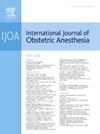Peripartum anesthesia management and outcomes of patients with congenital heart disease: a single-center retrospective analysis (2009–2023)
IF 2.6
3区 医学
Q2 ANESTHESIOLOGY
引用次数: 0
Abstract
Background
Advances in medicine have enabled more patients with congenital heart disease (CHD) to become pregnant. However, these patients face significant challenges during the peripartum period. Current peripartum anesthesia guidelines for CHD patients mainly rely on case reports and small series.
Methods
In this retrospective study at a high-volume tertiary care center, we analyzed peripartum anesthetic approaches, postpartum hemorrhage (PPH) incidence, and maternal outcomes in CHD patients stratified by the modified World Health Organization (mWHO) classification.
Results
Among 85 473 deliveries between 2009 and 2023, 409 occurred in 282 patients with CHD. Cesarean deliveries were significantly more frequent in mWHO class III, p=0.005. Labor epidural analgesia was the most common analgesic modality for vaginal deliveries (epidural rate was 71.1% with no differences between mWHO classes). Anesthesia management for cesarean deliveries varied significantly by class p<0.001. While spinal anesthesia was predominant in classes I and II, combined spinal-epidural anesthesia was more common in class III. PPH incidence was 6.4%, with no significant difference across classes, and no association was found between mWHO class severity and PPH risk (OR 0.97; 95% CI; 0.93 to 1.02, p=0.2). Higher mWHO classes correlated with significantly higher intensive care unit (ICU) admission rates, longer hospital stays, and one-year cardiac hospitalizations.
Conclusion
In this retrospective study on the peripartum anesthetic management and outcomes of CHD patients stratified by mWHO class, cases with greater mWHO class were more likely to deliver preterm, by cesarean delivery, with a combined spinal-epidural anesthetic and an arterial line placement for that cesarean delivery. They overall had a longer hospital stay and were more likely to be admitted to the ICU. However, the overall risk of PPH did not increase with mWHO class severity.
先天性心脏病患者的围产期麻醉管理和预后:单中心回顾性分析(2009-2023 年)
医学的进步让更多先天性心脏病(CHD)患者得以怀孕。然而,这些患者在围产期面临着巨大的挑战。目前针对先天性心脏病患者的围产期麻醉指南主要依赖于病例报告和小型系列研究。在这项在一家大容量三级医疗中心进行的回顾性研究中,我们分析了根据世界卫生组织(mWHO)修正分类法分层的 CHD 患者的围产期麻醉方法、产后出血(PPH)发生率和产妇预后。在2009年至2023年期间的85 473例分娩中,有409例发生在282名心脏病患者身上。在 mWHO 分级 III 中,剖宫产的发生率明显更高,=0.005。分娩硬膜外镇痛是阴道分娩最常见的镇痛方式(硬膜外镇痛率为 71.1%,mWHO 分级之间无差异)。不同级别的剖宫产麻醉管理差异显著,<0.001。脊髓麻醉在 I 级和 II 级中占主导地位,而脊髓-硬膜外联合麻醉在 III 级中更为常见。PPH发生率为6.4%,各等级之间无明显差异,mWHO等级严重程度与PPH风险之间无关联(OR 0.97;95% CI;0.93至1.02,=0.2)。较高的 mWHO 分级与较高的重症监护室(ICU)入院率、较长的住院时间和一年的心脏病住院率相关。在这项按 mWHO 分级对心脏病患者的围产期麻醉管理和预后进行分层的回顾性研究中,mWHO 分级越高的病例越有可能早产、剖宫产,并在剖宫产时进行脊髓硬膜外联合麻醉和动脉置管。总体而言,他们的住院时间更长,更有可能住进重症监护室。然而,PPH的总体风险并没有随着mWHO分级的严重程度而增加。
本文章由计算机程序翻译,如有差异,请以英文原文为准。
求助全文
约1分钟内获得全文
求助全文
来源期刊
CiteScore
4.70
自引率
7.10%
发文量
285
审稿时长
58 days
期刊介绍:
The International Journal of Obstetric Anesthesia is the only journal publishing original articles devoted exclusively to obstetric anesthesia and bringing together all three of its principal components; anesthesia care for operative delivery and the perioperative period, pain relief in labour and care of the critically ill obstetric patient.
• Original research (both clinical and laboratory), short reports and case reports will be considered.
• The journal also publishes invited review articles and debates on topical and controversial subjects in the area of obstetric anesthesia.
• Articles on related topics such as perinatal physiology and pharmacology and all subjects of importance to obstetric anaesthetists/anesthesiologists are also welcome.
The journal is peer-reviewed by international experts. Scholarship is stressed to include the focus on discovery, application of knowledge across fields, and informing the medical community. Through the peer-review process, we hope to attest to the quality of scholarships and guide the Journal to extend and transform knowledge in this important and expanding area.

 求助内容:
求助内容: 应助结果提醒方式:
应助结果提醒方式:


